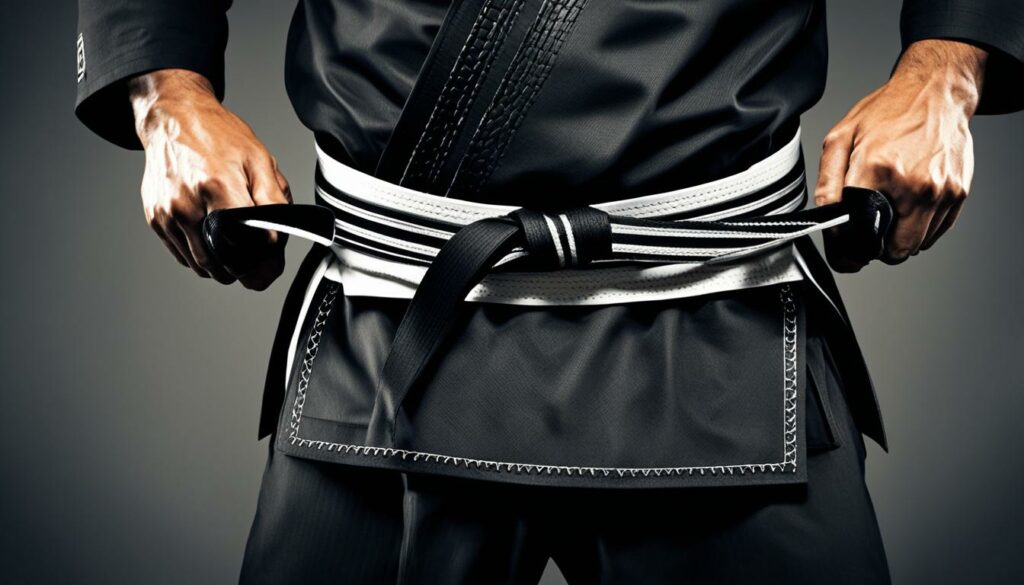As a martial arts practitioner, understanding the karate belt ranking system is essential for tracking progress and setting goals. The belt colors and order in karate symbolize the levels of skill and experience achieved by practitioners. In this article, I will guide you through the history, belt order, and requirements of the karate belt system. Let’s dive in!
Key Takeaways:
- The karate belt ranking system categorizes practitioners based on skill and experience levels.
- The belt colors and order signify different proficiency levels, starting from white for beginners and progressing to black for advanced practitioners.
- Each belt level in karate has specific requirements that practitioners must fulfill, such as pattern demonstrations, sparring skills, and board breaking techniques.
- Progression through the belt levels requires dedication, discipline, and continuous training.
- Achieving the black belt rank, the highest level in karate, signifies mastery and expertise in the martial art.
History of the Taekwondo Belt Ranking System
The belt ranking system in Taekwondo has a rich history that can be traced back to its roots in Judo. Initially created by Jigoro Kano in early 20th-century Japan, the concept of colored belts was introduced to distinguish students and competitors. This innovative system quickly gained popularity and was adopted by various martial arts disciplines, including Taekwondo.
Although the specific belt colors and order may vary slightly among different martial arts, the fundamental principles behind the ranking system remain the same. The colored belts serve as a visual representation of a practitioner’s skill level and progress within their martial arts journey.
“The belt ranking system provides structure and motivation for students, inspiring them to continuously improve their skills and strive for the next level of proficiency.”
It is intriguing to consider the journey of the belt ranking system from its humble origins in Judo to its widespread adoption in Taekwondo and other martial arts today. This shared tradition among martial arts communities underscores the interconnectedness and mutual respect that exists within the martial arts world.
Belt Order in Taekwondo
In Taekwondo, practitioners progress through a series of belt levels, each associated with a specific color. The belt order starts with white for beginners and progresses through yellow, green, blue, and red. The highest rank is the black belt, which is further divided into different degrees. Each belt level has its own set of requirements, including pattern demonstrations, sparring skills, and board breaking techniques. Progression from one belt level to the next requires dedication and training.
Here is the belt order in Taekwondo:
- White Belt
- Yellow Belt
- Green Belt
- Blue Belt
- Red Belt
- Black Belt
Each belt level signifies a milestone in a practitioner’s journey towards mastery. The white belt represents a beginner, while the yellow belt indicates a basic understanding of fundamental techniques. As the practitioner progresses through the green and blue belts, their skills and knowledge continue to develop. The red belt signifies advanced proficiency, and finally, the black belt represents the highest level of achievement in Taekwondo.
Obtaining a black belt is a significant accomplishment, but it is important to remember that it is not the end of the journey. Within the black belt rank, there are different degrees that signify further expertise and experience. These degrees are typically denoted by additional stripes on the black belt.
It is worth noting that the specific requirements and testing criteria may vary between Taekwondo schools and organizations. However, the overall progression and order of the belt system remain consistent across most Taekwondo practices.
Karate Belt Levels and Requirements
In karate, the belt system is structured similarly to Taekwondo, where beginners start at the white belt level and progress through various colors, including yellow, green, blue, and red. Each belt level represents a certain skill and knowledge attainment in the martial art. To advance from one belt level to the next, karate practitioners must fulfill specific requirements that demonstrate their proficiency and understanding of the techniques and principles taught.
Karate Belt Levels
The karate belt levels follow a progressive order, with each belt representing a higher level of expertise and dedication. Here is a breakdown of the common karate belt colors and their respective levels:
- White Belt: The starting point for beginners, symbolizing purity and a blank canvas for learning.
- Yellow Belt: Signifies the commencement of basic techniques and knowledge.
- Green Belt: Represents growth and the development of fundamental skills.
- Blue Belt: Reflects further progression and proficiency in karate techniques.
- Red Belt: Indicates advanced knowledge and nearing mastery of karate.
After the red belt, practitioners aim to achieve the prestigious black belt rank, which represents the highest level of expertise and mastery in karate.
Karate Belt Requirements
To progress through the karate belt levels, practitioners must meet specific requirements set by their martial arts organization or school. These requirements generally include:
- Pattern Demonstrations: Demonstrating precise execution of a series of predefined movements, showcasing mastery and control.
- Sparring Skills: Displaying the ability to engage in controlled combat with opponents, focusing on technique, speed, and accuracy.
- Board Breaking Techniques: Exhibiting the power and precision to break boards with various strikes and kicks, emphasizing strength and control.
- Theory and Knowledge: Demonstrating an understanding of karate history, philosophy, terminology, and self-defense principles.
The time required to advance from one belt level to the next can vary depending on the individual’s dedication, training frequency, and the specific requirements set by their karate organization. On average, it may take several months of consistent training and practice to achieve each new belt rank.
Attaining higher belt levels in karate requires not only physical skill but also mental discipline, perseverance, and a commitment to personal growth. Each belt level represents a milestone in a practitioner’s journey, marking their progress and dedication to the art of karate.
Karate Black Belt Hierarchy
In the karate belt system, the black belt represents the pinnacle of achievement. It is the highest rank one can attain and signifies mastery and proficiency in the martial art. The black belt is not a single rank but is divided into different degrees, each denoting a higher level of skill and expertise.
At the top of the black belt hierarchy is the 10th-degree black belt, also known as the grandmaster rank. This rank is reserved for individuals who have dedicated their lives to the practice and mastery of karate. They possess exceptional knowledge, experience, and leadership skills, and are highly respected within the martial arts community.
As practitioners progress through the black belt levels, they embark on a journey of continuous growth and development. Each degree they attain represents a milestone in their karate journey, showcasing their ongoing commitment to excellence and their steadfast dedication to mastering the art.
Advancing through the black belt hierarchy requires a significant investment of time, effort, and discipline. It is not a journey for the faint-hearted, but for those who are willing to push themselves beyond their limits and strive for perfection.
Throughout their progression, black belt practitioners gain invaluable experience and knowledge. They become role models within the martial arts community, inspiring and guiding the next generation of karateka. They not only possess exceptional technical skills but also embody the core values of integrity, respect, and humility.
Achieving the black belt rank is a remarkable accomplishment that reflects the culmination of years of training and commitment. It represents the attainment of a level of expertise that few can reach. The black belt hierarchy stands as a testament to the rich legacy and tradition of karate, highlighting the continuous pursuit of personal growth and excellence within the martial arts.
Key Takeaways:
- The black belt is the highest rank in the karate belt system.
- It is divided into different degrees, with the 10th-degree black belt being the highest rank.
- Progression through the black belt hierarchy requires extensive training, discipline, and dedication.
- Black belt practitioners gain experience, knowledge, and leadership skills as they advance.
- Achieving the black belt rank represents mastery and proficiency in karate.
Conclusion
The karate belt ranking system is a fundamental aspect of martial arts, serving as a visual representation of a practitioner’s progress and skill level. Whether practicing Taekwondo, Judo, or karate, the belt system offers a structured path for individuals to advance and develop their abilities.
By setting specific goals and requirements for each belt level, martial artists can measure their growth and strive for new heights of expertise. This system not only fosters discipline and dedication but also provides a sense of achievement and motivation.
Becoming a black belt is the ultimate goal for many practitioners, but the journey is about more than just physical abilities. It’s a transformative experience that promotes personal growth, self-discipline, and perseverance. The karate grading system encourages individuals to push their limits, overcome challenges, and become the best martial artists they can be.


